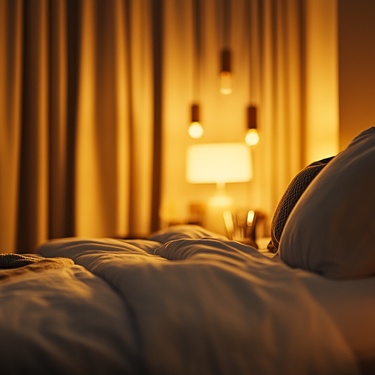
Creating a relaxing bedroom environment is one of the easiest ways to enhance your sleep quality. While many people think improving sleep requires complex solutions, the truth is that simple, intentional changes to your personal space can make a significant difference.
Whether you’re struggling with falling asleep or waking up refreshed, transforming your bedroom might be the solution you’ve been looking for. This blog walks you through practical tips to refresh your bedroom so you can achieve the restful sleep you deserve.
Transform Your Layout for a More Relaxing Flow
Where you place furniture can subconsciously influence how relaxed you feel in your bedroom. When a room feels cluttered or cramped, it creates visual stress that may prevent you from winding down.
A great first step is to evaluate your room’s layout. Ideally, your bed should face natural light, but you should avoid direct glaring sunlight that may disturb you in the early morning.
Think about the placement of larger furniture pieces as well. If possible, avoid having items like work desks or bulky storage units that serve as constant reminders of your responsibilities. Keeping your sleep space separate from work helps your brain associate the bedroom with rest and relaxation.
Choose the Right Colors for a Calming Atmosphere
The colors in your bedroom play a considerable role in how you feel when you enter the space. Bright or bold tones may be exciting for daytime use, but they can make it hard to shut your brain off at night.
Instead, opt for soft, muted tones like pale blues, greens, or neutral shades like beige or taupe. The soothing effects of these hues in your bedroom make it easier to relax and settle in for a good night’s rest.
Incorporate Comfortable Textures in Your Space
The physical comfort of your bedroom affects your quality of sleep as much as its visuals. Investing in high-quality sheets with a thread count of 300 or higher can significantly enhance your comfort. Natural fabrics, such as cotton or linen, are breathable options that keep you cozy all night long.
Layering is another way to improve both comfort and visual appeal. Add throws and extra pillows in soft fabrics like fleece or velvet to create an inviting bed setup. Have fun bringing out your inner interior designer to build your ideal space.
Tidy Up and Declutter for Mental Clarity
A clutter-free space is a must for promoting relaxation and reducing stress. A messy bedroom can serve as a visual overload, keeping your brain from switching into rest mode.
Start by eliminating items that don’t belong in the bedroom or that you haven’t used in a while. Donate old clothes, recycle paper clutter, and store seasonal items elsewhere so your room feels less congested.
Organized storage solutions also play a key role in maintaining tidiness. Consider stylish baskets, under-bed storage boxes, or built-in shelving to keep everything in place. Don’t underestimate the power of clear surfaces to make your room feel more peaceful.
Optimize the Air and Temperature in Your Room
Your bedroom’s air quality and temperature can make or break your ability to sleep soundly through the night. Stuffiness or overly warm conditions can make the atmosphere uncomfortable, leading to disrupted sleep. Make sure the ventilation works in your room to maintain a cool environment.
Air purifiers can help you get better sleep, especially if you have allergies. A purifier can reduce airborne particles, leaving you with cleaner, fresher air that allows you to breathe easily during the night. Combine this with maintaining an optimal bedroom temperature of around 65 degrees Fahrenheit for a perfect sleep-friendly environment.
Use Lighting To Set the Right Mood
Lighting can dramatically impact how quickly you fall asleep and how well you stay asleep through the night. Harsh overhead lights can signal to your brain that it’s time to be awake, even when you’re winding down. Instead, incorporate dimmable lighting or warm light sources like bedside lamps to create a calm atmosphere for the evening hours.
Smart lighting options are an excellent addition if you want to program your lights to dim gradually as bedtime approaches. Alternatively, string lights or LED strips tucked near the bed provide a soft, inviting glow without being disruptive.
Bring the Outside In
Adding natural elements to your space creates a tranquil environment for better sleep. Houseplants like snake plants, peace lilies, or pothos in decorative DIY pots are low-maintenance options that can improve indoor air quality while adding vibrant, calming energy to your room. Placing plants near the bed or by windows gives your room a fresh and inviting look.
Wooden furniture, natural fiber rugs, or wicker accents can also work nature-inspired textures into your bedroom design. These subtle details create a serene environment where you can unwind, leaving the hustle of the day behind.
Add Personal Touches That Reflect Calmness
Your bedroom can be both tranquil and reflect your personal style. The key is to avoid overwhelming the space with too many distracting accessories. Stick to thoughtful DIY decor choices that integrate smoothly with your calming theme.
Hanging minimalist art pieces in soft tones or incorporating meaningful photographs of trips or loved ones into simple frames brings an intimate and personal element to the room.
Refresh Your Bedroom, Reclaim Your Sleep
Refreshing your bedroom means creating a sanctuary where your body and mind can relax at the end of each day. Transforming your bedroom into a haven takes intentionality and effort, but it’s an incredibly worthwhile project. After all, who wouldn’t want to wake up feeling rested, refreshed, and ready to take on the day?
You don’t need to spend a fortune to make impactful changes. Focus on what works for your personal space and preferences—for example, swapping out harsh lighting, decluttering, or even introducing a few plants can completely change the mood. This is your space, so leave your personal touch to make it work for you.
Take the first step today. Look around your current bedroom and decide what’s working and what isn’t. From there, you can slowly work your way toward the ultimate goal of a restful, sleep-inducing bedroom.
Bio: Casey is a passionate copyeditor highly motivated to provide compelling SEO content in the digital marketing space. Her expertise includes a vast range of industries from highly technical, consumer, and lifestyle-based, with an emphasis on attention to detail and readability.




















